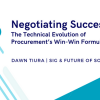I can recall being on vacation in Hong Kong with my wife as we were walking through the famous shopping district in Mongkok. Here you can buy Class A imitation goods of leading brands at far lower prices than the real brand and few would ever know the difference. Or, if you are like me, you will negotiate (aka: haggle) for an even better price. As I plied my finely honed negotiating skills on the unsuspecting merchants, the price kept getting lower and lower. My wife would say, “Stop, stop already” and she would eventually walk away in embarrassment. I remained however, and got the price far lower than when she had left. I explained to her, “Until they say, ‘No!’, then they are comfortable it is still a good deal for them as well, and they will make a profit. They won’t sell at a loss.”
Earlier in my career, as president of a BPO subsidiary of ACS (now Xerox), I had the opposite problem. I was put into the subsidiary to orchestrate a turnaround of their number-one Money Losing Unit (MLU in ACS parlance). I was the fifth president in five years. The subsidiary was grossly unprofitable when I took control and employees were doing sick-outs to send a message to management. This was not going to become profitable by doing the same thing a little better. The model was broken. Nearly half our customers were unprofitable and had lost confidence in us, resulting in two customers threatening to sue us. Our client list was to die for: category-leading brands in virtually every industry. The only problem was, through mismanagement, the accounts had become unprofitable. My predecessors had put lipstick on the bulldog, tried smoke and mirrors and hoped things would improve…or at least look better. They did not. While we did excellent work, flawlessly processed claims, and managed a very respected contact centre of 144 people, which disbursed more than $2 billion annually in funds on behalf of our customers, we were haemorrhaging red ink.
Tough decisions had to be made. I chose to jettison our unprofitable customers, along with any customer whose account was not of sufficient size to warrant a single, full-time account manager. In the end, we let go more than half of our customers. Some were so small the customer did not even know we were managing their money. This had a corresponding impact on revenue… but it was not proportionate in size. The revenue drop was only 11%… or, said another way, 89% of our revenue came from 44% of our customers.
Left unchanged, we would have lost our biggest and best customers first. We needed to reinvent the underlying business model also, or in time we would slowly go out of business. I inverted our value proposition and stopped leading with commodity transaction processing. Instead we would offer value-added services for an additional premium. We now offered value-laden offerings designed from direct input from our customers, with the transaction processing already baked into the price. No more smoke and mirrors – as this was the basis of the lawsuits. We had to fundamentally merge the two former competitors ACS had previously bought, into a single cohesive subsidiary, on a single IT platform. An interesting thing happened when we told the customers the truth: they agreed to drop the lawsuits and work with us to solve the problem and bear the pain of a system conversion – as long as we did not go back to our old ways. They became part of the change management team and were excited to be part of the solution. Within 12 months from when I started, we were profitable again.
In my next role, I was the Head of Sales for North America for the outsourcing division of Unisys. I did not win favour with some of my sales team when I said, “We will no longer pursue bad deals…it costs money, we probably won’t win them anyways, and why do we want to win a bad deal?” I later replaced those who did not embrace the new direction. We went on to have the second best quarter in the company’s history less than 12 months later – making 40% of our number for the year in the first quarter alone.
Sometimes it pays to say “No”. In a pursuit for a leading insurance company, I was invited to bid on an $8 million RFP they were about to issue. If implemented, it was a forward-thinking idea that would revolutionise how the process was done at the time. Normally the type of thing my employer would have excelled at, if we bid and won. But, my gut told me, we were invited to bid as the stalking horse, and no matter what we bid, we would not win. I declined to bid. The prospect senior executive was more than a little perturbed and had a few emotionally charged unkind words to say in response.
About 18 months later, the same senior executive called me in to bid on a $20 million opportunity. Somewhat surprised, I asked, “So…why did you call me? I am surprised you even remembered me, much less kept my business card.” He replied, “Nearly two years ago you sat in front of me and declined to bid on a dream project. Every other leading vendor submitted a bid. By declining to bid you earned my respect as someone who makes good business decisions, and were not the typical salesperson who would say, ‘Yes!’ to any deal in the hope of getting a commission. So on this opportunity, I am giving you right of first refusal. Bring me a good deal, and the deal is yours. If you decline, I will put it out for competitive bid and you will not be included”. I replied, “Okaaaay…so what happened to the other deal?” He replied, “It died…we could not get Board approval.” We went on to win the new deal, sole-sourced.
Having been a successful bag-carrying salesperson, as well as a successful Head of Sales for more than one leading company, I am often surprised that when a deal is good, profitable and can be used as a flagship reference account, it is referred to as a “Team Sale” – yet if the deal is won, but has problems and/or is not profitable, that somehow the salesperson is to blame as if he/she did the deal in complete isolation with no input from the same “team”.
At every company which I worked, the sales model is essentially the same. And the bigger the company, the more similar it becomes. The salesperson is tasked with evangelising the company to the market. They take the positioning and messaging provided by marketing, then go out into the swamp and start kissing frogs one at a time, hoping to find a prince. They manage the overall account penetration strategy; they personally get close to the prospects, nurturing them for when the time is right. Sort of like the deep moles opposing sides planted within their enemy during the Cold War.
Once an opportunity is identified, the salesperson is charged with helping the prospect to cultivate the opportunity into one shaped to his/her company’s competitive advantage. Whether sole-sourced or put out for bid, a team of highly capable support personnel, comprised of Finance, Legal, HR, Operations, IT, SMEs, Sales Support, and others at all levels in the company come together to develop the (hopefully) winning solution. It has been kicked around numerous times. The profit has been padded by Operations to ensure it will not be a nightmare to manage, legal has padded the price to allow for the risk, HR has padded to account for the worst possible scenario…and others all weigh in. They have created the perfect deal (for their company) that will never sell. So senior management sharpens the pencils for everyone and slowly it gets chiseled down to a deal that is, at least, somewhat competitive. Everyone signs off it is a deal that they can live with if won. Speak now or forever hold your peace. The salesperson may not have even had a vote in what the deal ultimately looked like, though they likely did have input. But regardless the salesperson has their marching orders: “Go sell this deal we have crafted.”
Assuming the proposed deal is competitive, it enters successive rounds of refinement and negotiation. Again the salesperson has input, but seldom a vote. He/she is tasked with representing the deal only, since few, if any, have signature authority for a $20 million, $100 million, or $1 billion deal. Most don’t even have signature authority for $1,000. The deal gets negotiated, everyone signs off that the deal is good and worth doing. But as the saying goes, “Success has many fathers, but failure is an orphan.”
Here are some tips for improving sales performance and avoiding bad deals:
1. Try to stay objective. “No!” can be a good decision too. Avoid the uninformed perspective that “we can’t win if we don’t bid”. You will not win most deals anyways, so be selective and you will not throw away a lot of bid dollars on legions of deals that you were likely not destined to win. Selling is not a lottery; it is not luck. If you have a win percentage in the single digits, then you are not saying “No” enough.
2. If the deal catches you by surprise, don’t be surprised if you don’t win. People buy from people they know and trust. If you have no prior account intelligence and no executive level relationships, you have virtually no chance of winning. Can a blind squirrel still find an acorn? Yes.
3. Have a bid qualification process and objective deal assessment criteria, and stick to it. Too many companies say they have a clearly defined market, yet still bid on anything and everything. In select circumstances, bidding outside of your target may be fruitful, but are you positioned to win against established competitors at that account and in their home court, playing the game their way? (See #2 above).
4. Do a regular pipeline analysis as well as a win/loss analysis – and be brutally honest. You will not improve by changing the criteria to fit the circumstances. Don’t use it as an opportunity to find a scapegoat or to justify firing someone as that will alter the results. Separate the people from the process. If the process is flawed fix it. If the people do not have the skills required to succeed, then develop them or find new ones. You cannot make a cat a dog. Sometimes too, it is the sales management that is the problem, not the salespeople.
5. Don’t manage by intimidation. If the sales team and the supporting cast always say yes to your ideas, then you have a weak team, or your reputation precedes you. In the case of the latter, look in the mirror when a deal turns bad. Learn to lead, not dictate. Respect those who challenge you. They will learn from your leadership and you might see a different perspective that could result in a better deal.
6. Know your value in the deal and be sure it is clearly articulated and differentiated. BUT: be sure the value you are offering is the value the prospect is seeking. If the prospect expects it to be already included as table stakes, then your value-add has been reduced to a commodity. What the true value is that the client is seeking may not be articulated in any bid discovery documents. Can you quantify the value you are going to deliver? Can you promise it? Will you guarantee it in a shared risk, shared reward model? If you do not know and are guessing what the client really needs and wants, you likely will not win. But if you do, you may fail to deliver to their expectations as you may not know why they really chose you.
7. When structuring and pricing your deal, it is not enough to understand the prospect’s business. You need to think like the prospect. If you switched sides a month ago and are now leading the procurement for the prospect, would you feel it is a great deal on first pass – knowing it is likely padded to the gills? To this end, it is good to establish ‘green team’ and ‘red team’ reviews. The green team is tasked with enhancing the competitiveness of the deal, ensuring it reflects the unique value the company offers, and ensures it meets the prospect’s stated and unstated needs. The red team finds all the problems with the proposal: how the competition will counter or diminish our solution, unrealistic pricing, where we have missed key value points in the buyer’s eye. Their role is to act, objectively, like the buyer, to get it to a deal that resonates with the prospect – and one they will be likely to buy.
8. Selling traditional outsourcing is closer to M&A than it is the sale of hardware, software or services. It is not about winning as much as it is about getting a good deal structured. You are competing with the other vendors – not the prospect. Nor are you competing against the third-party advisor if one is working the deal. For the buyer, beating down the vendor on price to the point where they have insufficient margin is a self-fulfilling prophecy for missed expectations. Do you really want a vendor who is struggling because they are strained to serve you? Do you want their “B” team working your account? Do you want them to bring you innovative ideas to cut cost and increase revenue? Then be sure the proper financial incentives are in place to allow them to earn their needed margin if they meet or exceed your expectations.
9. If you are most likely to lose, it is best to lose early. On many occasions I had the chance to ‘bid’ on business where my company was not well positioned, and the cost of the pursuit could exceed $250,000 or more over a 12-month period. In these type of situations, it’s best to say “no” early and walk away than to bid in vain. It is not wise to bid on everything in the hope of winning. Pick your moments. As Sun Tzu once advised: “The valiant army fights every battle in the hope of winning. The victorious army selects which battles it must win before engaging with the enemy.”
Sales is as much about making good decisions as it is about closing good deals. Don’t be star-struck by every great logo or the revenue potential it represents. Stick to your principles, objectively qualify your deals, and be prepared to walk. Your win ratio will improve, as will your profitability, and you likely will win good deals worth keeping. Sometimes, “No!” is the right answer.






